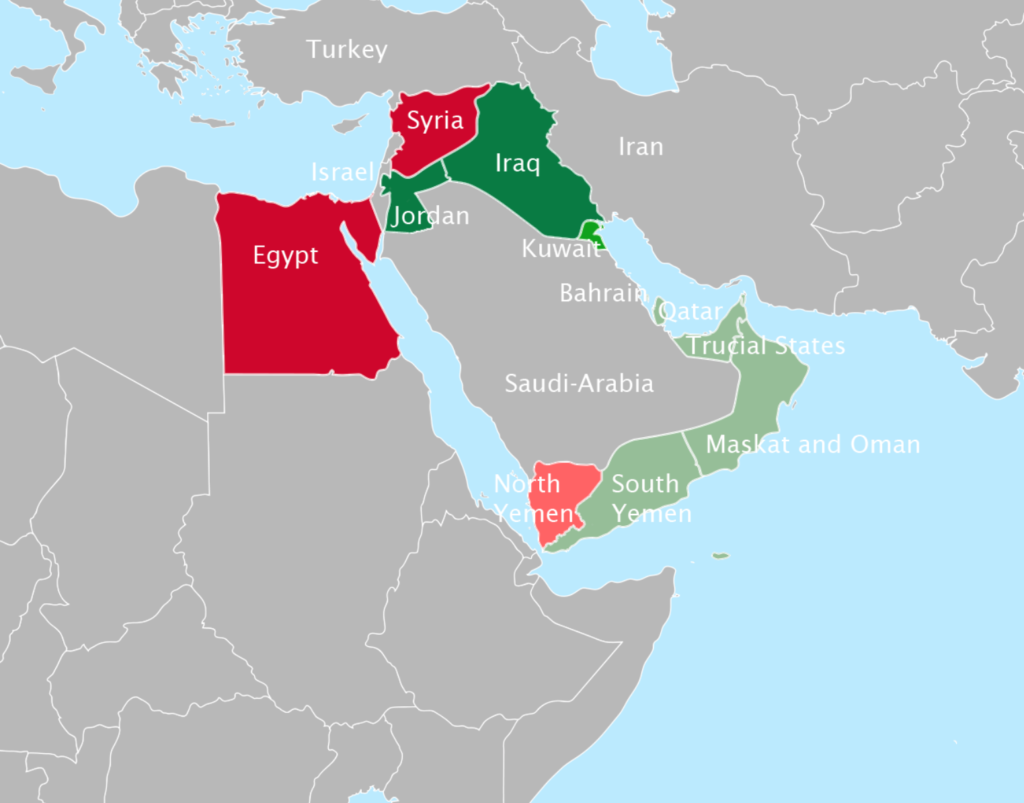A Brief History of Pan-Arabism

By Liam Nagle / Arab America Contributing Writer
Pan-Arabism as an ideology appeared at a similar time to various European nationalist movements, and for similar reasons, too. Much like the nationalist movements that swept through Europe in the 1800s, the goal of the ideology was to shake the yoke of imperialist rulers – first the Ottomans, then the Europeans – who sought to keep the nationality divided amongst themselves for their own gain. However, the ideology began to lose favor after two attempts at creating Pan-Arab states failed, resulting in the ideology’s gradual fade-out into the latter half of the 1900s.
The Origins of Pan-Arabism

Interestingly, like many of the European nationalist movements, the history of Arab nationalism may stem from Napoleon’s conquests. The Arab Nahda, or “Awakening”, was a cultural movement that flourished in the Arab regions of the Ottoman Empire that, among other things, served as the origins of Pan-Arabism. Napoleon’s emphasis on French patriotism has been considered one of the first instances of nationalist ideology – a concept which, as he invaded much of Europe, spread to their populations as well.
As such, these populations too began to associate themselves with these new nationalities which resulted in the Revolutions of 1848 and the rise of Irish, German, Polish, and various other nationalist movements. Arab nationalism, in traditional scholarship, was considered no different in origin. Considered to be brought about during Napoleon’s expedition in Egypt, the idea was that the cultural shock brought about during his invasion drove society in the Middle East and North Africa into a cultural revolution that brought out the ideas of Pan-Arabism. However, more contemporary scholarship also offers the view that various Arab scholars who traveled to Europe embraced the ideas there, and spread these views once they returned to the Middle East and North Africa.
Whatever the case, Pan-Arabism as an ideology developed throughout the 1800s. A primary proponent of the ideology was the writer and teacher Jurji Zaydan. A prominent figure during the Nahda, Zaydan had a profound influence on the creation of Modern Standard Arabic, which offered a universal language that Arabs could use to communicate with one another outside of their native dialects. In addition to this, however, he also wrote about how he believed the Arabic-speaking people from the Maghreb to the Persian Gulf were all one people.
In his opinion, the linguistic bonds between Arabs surpassed the religious, racial, and other divisions between them. The development of Pan-Arabism was helped further by the aspirations of King Hussein bin Ali of the Arab Revolt. The Arab Revolt was a resistance movement against the Ottoman Empire that sought to unify all Arabs under one country during World War One. However, although the Arab Revolt was victorious in defeating the Ottoman Empire, their conflicting goals with the British and French meant that the Arab world would instead be divided into smaller states under the control of European powers, rather than a unified and independent Arab entity.
Cold War Era

Pan-Arabism remained in a kind of hiatus during the colonial era. Most independence movements instead identified more with their country than the Arab ethnicity, and as such fought for their countries’ independence rather than for a unified Arab state. However, this view began to change after independence was steadily granted to many of these countries.
Two major ideological trends appeared that promoted Pan-Arabism – Nasserism and Ba’athism. Nasserism is an ideology that appeared in Egypt with Gamal Abdel Nasser’s assumption of power in the country in the 1950s. His victories against the British made him a very popular figure, and many embraced his ideas of nationalization, anti-colonialism, and Arab nationalism. Ba’athism, which was formed some years prior, followed similar tenets after the ideology’s establishment in Syria. Both ideologies spread throughout the Arab world, and their efforts were eventually successful. Egypt and Syria, both under the control of pro-Arab nationalist governments, unified into the United Arab Republic (UAR) in 1958. Nasser, under this new government, advocated for other countries to join.
Interestingly, unification between Arab states didn’t end there. In response to the creation of the United Arab Republic, the monarchies of Iraq and Jordan feared the new state’s growing power and influence. The two countries were ruled by the same family dynasty – the Hashemites – and therefore already had friendly relations with one another. Given these two factors, the two countries opted to give an alternative to the UAR – Iraq and Jordan also unified, creating the Arab Federation in 1958.
However, both of these unions were short-lived. The Arab Federation fell apart after Iraq underwent a coup d’etat that overthrew and killed the ruling family. The United Arab Republic, for its part, was dissolved due to the perception that Syria’s views were held as secondary to Egypt’s. Because of these failures, Pan-Arabism’s popularity began to decline – not helped by the Arab governments’ subsequent defeat in the 1967 Six-Day War, as well as the growing tensions between Shias and Sunnis.
While some countries continued to embrace the view into the 21st century – such as Syria and Iraq’s ruling Ba’athist parties – no real efforts have been made to unify Arab countries together on the basis of Arab nationalism. Instead, Pan-Arabism has mostly been replaced by two other major ideologies – narrower nationalist ideologies focused around a single country, and Pan-Islamism, both of which we see today.
Check out our Blog here!







